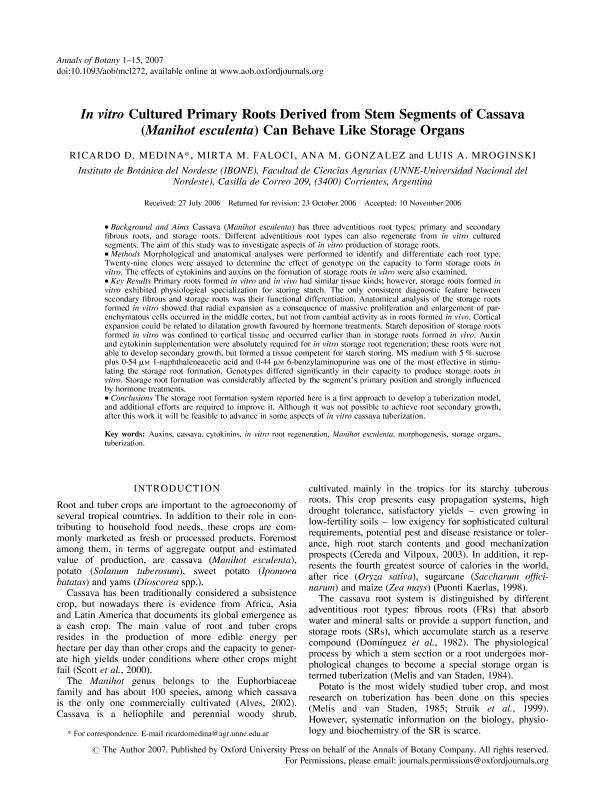Mostrar el registro sencillo del ítem
dc.contributor.author
Medina, Ricardo Daniel

dc.contributor.author
Faloci, Mirta Mabel

dc.contributor.author
González, Ana María

dc.contributor.author
Mroginski, Luis Amado

dc.date.available
2018-08-17T20:17:45Z
dc.date.issued
2007-03
dc.identifier.citation
Medina, Ricardo Daniel; Faloci, Mirta Mabel; González, Ana María; Mroginski, Luis Amado; In vitro cultured primary roots derived from stem segments of cassava (Manihot esculenta) can behave like storage organs; Oxford University Press; Annals of Botany; 99; 3; 3-2007; 409-423
dc.identifier.issn
0305-7364
dc.identifier.uri
http://hdl.handle.net/11336/56270
dc.description.abstract
Background and Aims. Cassava (Manihot esculenta) has three adventitious root types: primary and secondary fibrous roots, and storage roots. Different adventitious root types can also regenerate from in vitro cultured segments. The aim of this study was to investigate aspects of in vitro production of storage roots. Methods. Morphological and anatomical analyses were performed to identify and differentiate each root type. Twenty-nine clones were assayed to determine the effect of genotype on the capacity to form storage roots in vitro. The effects of cytokinins and auxins on the formation of storage roots in vitro were also examined. Key Results Primary roots formed in vitro and in vivo had similar tissue kinds; however, storage roots formed in vitro exhibited physiological specialization for storing starch. The only consistent diagnostic feature between secondary fibrous and storage roots was their functional differentiation. Anatomical analysis of the storage roots formed in vitro showed that radial expansion as a consequence of massive proliferation and enlargement of parenchymatous cells occurred in the middle cortex, but not from cambial activity as in roots formed in vivo. Cortical expansion could be related to dilatation growth favoured by hormone treatments. Starch deposition of storage roots formed in vitro was confined to cortical tissue and occurred earlier than in storage roots formed in vivo. Auxin and cytokinin supplementation were absolutely required for in vitro storage root regeneration; these roots were not able to develop secondary growth, but formed a tissue competent for starch storing. MS medium with 5% sucrose plus 0.54 mM 1-naphthaleneacetic acid and 0.44 mM 6-benzylaminopurine was one of the most effective in stimulating the storage root formation. Genotypes differed significantly in their capacity to produce storage roots in vitro. Storage root formation was considerably affected by the segment’s primary position and strongly influenced by hormone treatments. The storage root formation system reported here is a first approach to develop a tuberization model, and additional efforts are required to improve it. Although it was not possible to achieve root secondary growth, after this work it will be feasible to advance in some aspects of in vitro cassava tuberization.
dc.format
application/pdf
dc.language.iso
eng
dc.publisher
Oxford University Press

dc.rights
info:eu-repo/semantics/openAccess
dc.rights.uri
https://creativecommons.org/licenses/by-nc-sa/2.5/ar/
dc.subject
Auxins
dc.subject
Cassava
dc.subject
Cytokinins
dc.subject
In Vitro Root Regeneration
dc.subject
Manihot Esculenta
dc.subject
Morphogenesis
dc.subject
Storage Organs
dc.subject
Tuberization
dc.subject.classification
Ciencias de las Plantas, Botánica

dc.subject.classification
Ciencias Biológicas

dc.subject.classification
CIENCIAS NATURALES Y EXACTAS

dc.title
In vitro cultured primary roots derived from stem segments of cassava (Manihot esculenta) can behave like storage organs
dc.type
info:eu-repo/semantics/article
dc.type
info:ar-repo/semantics/artículo
dc.type
info:eu-repo/semantics/publishedVersion
dc.date.updated
2018-08-13T14:48:28Z
dc.identifier.eissn
1095-8290
dc.journal.volume
99
dc.journal.number
3
dc.journal.pagination
409-423
dc.journal.pais
Reino Unido

dc.journal.ciudad
Oxford
dc.description.fil
Fil: Medina, Ricardo Daniel. Consejo Nacional de Investigaciones Científicas y Técnicas. Centro Científico Tecnológico Conicet - Nordeste. Instituto de Botánica del Nordeste. Universidad Nacional del Nordeste. Facultad de Ciencias Agrarias. Instituto de Botánica del Nordeste; Argentina
dc.description.fil
Fil: Faloci, Mirta Mabel. Consejo Nacional de Investigaciones Científicas y Técnicas. Centro Científico Tecnológico Conicet - Nordeste. Instituto de Botánica del Nordeste. Universidad Nacional del Nordeste. Facultad de Ciencias Agrarias. Instituto de Botánica del Nordeste; Argentina
dc.description.fil
Fil: González, Ana María. Consejo Nacional de Investigaciones Científicas y Técnicas. Centro Científico Tecnológico Conicet - Nordeste. Instituto de Botánica del Nordeste. Universidad Nacional del Nordeste. Facultad de Ciencias Agrarias. Instituto de Botánica del Nordeste; Argentina
dc.description.fil
Fil: Mroginski, Luis Amado. Consejo Nacional de Investigaciones Científicas y Técnicas. Centro Científico Tecnológico Conicet - Nordeste. Instituto de Botánica del Nordeste. Universidad Nacional del Nordeste. Facultad de Ciencias Agrarias. Instituto de Botánica del Nordeste; Argentina
dc.journal.title
Annals of Botany

dc.relation.alternativeid
info:eu-repo/semantics/altIdentifier/url/https://academic.oup.com/aob/article/99/3/409/2464745
dc.relation.alternativeid
info:eu-repo/semantics/altIdentifier/doi/http://dx.doi.org/10.1093/aob/mcl272
dc.relation.alternativeid
info:eu-repo/semantics/altIdentifier/url/https://www.ncbi.nlm.nih.gov/pmc/articles/PMC2802953/
Archivos asociados
